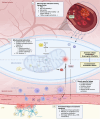Towards an understanding of physical activity-induced post-exertional malaise: Insights into microvascular alterations and immunometabolic interactions in post-COVID condition and myalgic encephalomyelitis/chronic fatigue syndrome
- PMID: 39240417
- PMCID: PMC11825644
- DOI: 10.1007/s15010-024-02386-8
Towards an understanding of physical activity-induced post-exertional malaise: Insights into microvascular alterations and immunometabolic interactions in post-COVID condition and myalgic encephalomyelitis/chronic fatigue syndrome
Abstract
Background: A considerable number of patients who contracted SARS-CoV-2 are affected by persistent multi-systemic symptoms, referred to as Post-COVID Condition (PCC). Post-exertional malaise (PEM) has been recognized as one of the most frequent manifestations of PCC and is a diagnostic criterion of myalgic encephalomyelitis/chronic fatigue syndrome (ME/CFS). Yet, its underlying pathomechanisms remain poorly elucidated.
Purpose and methods: In this review, we describe current evidence indicating that key pathophysiological features of PCC and ME/CFS are involved in physical activity-induced PEM.
Results: Upon physical activity, affected patients exhibit a reduced systemic oxygen extraction and oxidative phosphorylation capacity. Accumulating evidence suggests that these are mediated by dysfunctions in mitochondrial capacities and microcirculation that are maintained by latent immune activation, conjointly impairing peripheral bioenergetics. Aggravating deficits in tissue perfusion and oxygen utilization during activities cause exertional intolerance that are frequently accompanied by tachycardia, dyspnea, early cessation of activity and elicit downstream metabolic effects. The accumulation of molecules such as lactate, reactive oxygen species or prostaglandins might trigger local and systemic immune activation. Subsequent intensification of bioenergetic inflexibilities, muscular ionic disturbances and modulation of central nervous system functions can lead to an exacerbation of existing pathologies and symptoms.
Keywords: ME/CFS; Physical activity; Post COVID condition; Post-exertional malaise; SARS-CoV-2.
© 2024. The Author(s).
Conflict of interest statement
Declarations. Competing interests: The authors have no competing interests to declare that are relevant to the content of this article.
Figures

References
-
- Adjaye-Gbewonyo D, Vahratian A, Perrine CG, Bertolli J. Long COVID in Adults: United States, 2022. NCHS Data Briefs No 480. 2023. - PubMed
Publication types
MeSH terms
LinkOut - more resources
Full Text Sources
Medical
Research Materials
Miscellaneous

